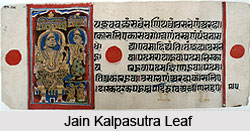 Originally there were 14 Purvas and 11 Angas in the Jaina scripture. Purvas were transmitted orally, thus in due course of time have been lost. Hence 11 Angas now form the main Jaina religious literature. Besides that there are 22 Upangas, 10 Pakinnakas, 6 Chedas, 4 Mula-sutras and 2 other Sutras. Out of 11 Angas the Acharanga formulates the rules of conduct for the monks and Sutrakrtanga describes the Jaina rites and points out its distinctive features. Uvasagadasao is the 7th Anga among the 11 Angas. Formerly the Jaina scripture was written in Ardha Maghadhi. Later it was written more systematically in Prakrit and Sanskrit.
Originally there were 14 Purvas and 11 Angas in the Jaina scripture. Purvas were transmitted orally, thus in due course of time have been lost. Hence 11 Angas now form the main Jaina religious literature. Besides that there are 22 Upangas, 10 Pakinnakas, 6 Chedas, 4 Mula-sutras and 2 other Sutras. Out of 11 Angas the Acharanga formulates the rules of conduct for the monks and Sutrakrtanga describes the Jaina rites and points out its distinctive features. Uvasagadasao is the 7th Anga among the 11 Angas. Formerly the Jaina scripture was written in Ardha Maghadhi. Later it was written more systematically in Prakrit and Sanskrit.
Jainas are essentially traders from the time of Makkhali Gosala, for they desist from agriculture. They own a good deal of wealth in India. They fear that while digging the soil, they are likely to kill insects and this killing would mean hmsa. The Jainas have still managed to survive all these years, but Buddhism has almost disappeared from the land of its origin. The main reason is that Jainas have nothing to oppose Brahmanism. They do not admit caste, but accept Brahmin priesthood at many of their functions. Secondly, they have adopted many popular gods from Hinduism. Besides this, their own four pillars of Karma-Samsara-Jnana-Mukti have been assimilated into Hinduism.
The pancha-mahavrata of Jainism, Jinana-Muktihwe (Satya, asteya, brahmacharya, ahimsa and aparigraha), has been adopted completely by Hinduism though not with the same rigour. Yoga and austerities now are as much Jaina as Hindu for the last so many years. Jainas have become so much Hinduistic that they have also adopted Vaisriavism. As a matter of fact even intercaste-marriage is permitted between some of the vegetarian Hindus and Jainas.



















